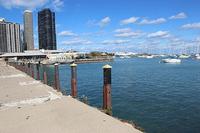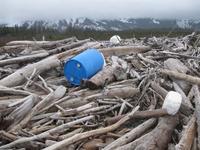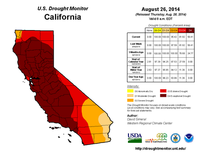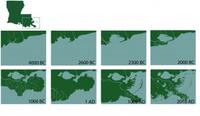-
Florida's First Coast region trying to cope with rising seas
City planners in Florida’s First Coast region are taking steps to avoid massive destruction to property and human life as sea level rise is expected to cause mass flooding and super storms during the next few decades. Some groups are lobbying for coastal property-insurance reforms, while others are researching ways to help historic properties manage flooding.
-
-
Exploring ways to deal with Great Lakes water-level changes

Extreme water-level fluctuations in the Great Lakes, including historic lows on lakes Michigan and Huron in 2013 and substantial upward trends in 2014, are creating serious challenges for many shoreline property owners, tourism-related businesses, municipal planners, and others. To help these community decision makers determine the best strategies for dealing with these water-level changes, a two-tiered, two-year research initiative has been launched with the goal of developing information, tools, and partnerships to help decision makers address challenges and opportunities posed by water-level variability.
-
-
Water’s role in the rise and fall of the Roman Empire
The Roman Empire, stretching over three continents and persisting for many centuries, was home to an estimated seventy million people. In such a vast area ensuring a stable food supply was no easy task, particularly given the variable and arid climate of the Mediterranean region. Smart agricultural practices and an extensive grain-trade network enabled the Romans to thrive in the water-limited environment of the Mediterranean, a new study shows. The stable food supply brought about by these measures, however, promoted population growth and urbanization, pushing the Empire closer to the limits of its food resources.
-
-
Turning excess space into apartments as an incentive for earthquake-retrofitting of buildings
San Francisco is dealing with a housing shortage at the same time that city officials are trying to get landlords to retrofit buildings which are at risk of crumpling during a severe earthquake. In 2013, Mayor Ed Lee approved a bill that mandates retrofits for soft-story multi-unit residential buildings over the next four to seven years. Roughly 4,800 buildings of two or more stories, containing five or more apartment units, which were approved for construction before January 1978, have to be retrofitted, according to the mandate.A member of San Francisco’s Board of Supervisors, recently proposed that building owners of at-risk apartment buildings be allowed to finance earthquake retrofits by converting garages, basements, and other excess space into apartments –a plan which would also increase the city’s housing stock.
-
-
FEMA will review denied or underpaid Sandy-related claims by owners of damaged homes
Hundreds of homeowners who were denied claims for damages caused by Hurricane Sandy will now have their claims reviewed, according to a series of reforms by the Federal Emergency Management Agency (FEMA), which operates the National Flood Insurance Program. According to FEMA administrator, W. Craig Fugate, contractors hired to handle homeowner claims allegedly conspired to underpay flood insurance settlements to homeowners.
-
-
Another wave of tsunami debris, possible invasives, to reach West Coast

Scientists monitoring incoming tsunami debris were taken aback last spring when some thirty fishing vessels from Japan washed ashore along the Pacific Northwest coast — many of them covered in living organisms indigenous to Asia. Incidence of wayward skiffs and other tsunami debris subsequently declined sharply over the summer because of seasonal shifts in the winds. Now, those winds and currents have returned to their winter-spring pattern and scientists are expecting more items to wash ashore — even though it is nearing four years since a massive earthquake and tsunami shook Japan.
-
-
Re-thinking Southern California earthquake scenarios

New three-dimensional (3D) numerical modeling that captures far more geometric complexity of an active fault segment in southern California than any other, suggests that the overall earthquake hazard for towns on the west side of the Coachella Valley such as Palm Springs and Palm Desert may be slightly lower than previously believed.
-
-
Growing cybersecurity threats offer opportunities for cybersecurity businesses
A 2013 report from the U.S. Computer Emergency Readiness Team(US-CERT) noted that the number of cyberattacks reported by federal agencies had skyrocketed 782 percent since 2006, to nearly 49,000, in 2012. Today, the figure is much higher. The increasing threat of cyberattacks from domestic and foreign actors has opened up opportunities for cybersecurity professionals, many of whom held positions with the U.S. military or intelligence agencies. For the private sector, cybersecurity spending is expected to reach $71.1 billion this year, and expected to grow about 9 percent annually through 2016.
-
-
2012-14 California drought the worst in 1,200 years
New research shows that the California drought of 2012-14 has been the worst in 1,200 years. California is the world’s eighth largest economy and the source of a substantial amount of U.S. produce. Surface water supply shortages there have impacts well beyond the state’s borders. The research indicates that natural climate system variability is compounded by human-caused climate change and that “hot” droughts such as the current one are likely to occur again in the future.
-
-
Predicting future droughts in California

According to a new NOAA-sponsored study, natural oceanic and atmospheric patterns are the primary drivers behind California’s ongoing drought. A high pressure ridge off the West Coast (typical of historic droughts) prevailed for three winters, blocking important wet season storms, with ocean surface temperature patterns making such a ridge much more likely. The study found no conclusive evidence linking human-caused climate change and the California drought.
-
-
Insurance industry needs support to address effects of climate change on the built environment
A new report finds that the increasing frequency of extreme weather brought on by climate change adversely affects real estate values and increases the probability of property damage occurring in urban areas. In the last ten years alone, direct losses in real estate and infrastructure as a result of natural disasters has tripled, reaching $150 billion per year. The report highlights the steps the insurance industry has taken to adopt risk standards for climate change across the industry, from catastrophe models and scenario analysis to insurance products that incentivize risk-reducing building practices.
-
-
CO2 warming effects already felt a decade after being emitted
It takes just ten years for a single emission of carbon dioxide (CO2) to have its maximum warming effects on the Earth. This is according to researchers who have dispelled a common misconception that the main warming effects from a CO2 emission will not be felt for several decades. This means that the benefits from emission reductions — the avoidance of extreme weather events such as droughts, heatwaves, and flooding — will be felt by those who have worked to curb the emissions and not just future generations. Some of the bigger climate impacts from warming, however, such as sea-level rise, melting ice sheets, and long-lasting damage to ecosystems, will have a much bigger time lag.
-
-
Research shows how global warming links to carbon emissions
A team of researchers from the Universities of Liverpool, Southampton, and Bristol have derived the first theoretical equation to demonstrate that global warming is a direct result of the build-up of carbon emissions since the late 1800s, when man-made carbon emissions began. The results are in accord with previous data from climate models. The results show every million-million tons of carbon emitted will generate one degree Celsius of global warming. They also show that the build-up of carbon emitted over the last 200 years will then last for many centuries to millennia even if carbon emissions are subsequently phased out.
-
-
Southeastern Louisiana has a problem: "The sea is rising and the land is sinking"

Southeastern Louisiana is drowning at the rate of one football field per hour, totaling up to sixteen square miles annually. In just eighty years, sea level rise, fossil fuel extraction, and having too few wetlands separating the Gulf from the flood protection levee systems have caused some 2,000 square miles of Louisiana’s coastal landscape to sink into the Gulf of Mexico. The issues facing Louisiana’s southeastern coast pose a threat to American energy and economic stability. A $50 billion, 50-year coastal restoration plan, formulated in 2007, is yet to be accepted and funded, but experts note that if sea-level rise is as bad as the worst case scenario, several projects at the heart of the restoration plan would become infective.
-
-
New York wants its own weather detection service
In the face of recent devastating snowfall in some regions, Governor Andrew Cuomo has announced that the state government will remain committed to its plans for the New York Advanced Weather Detective System, a state-run and focused weather service and alert system. Officials said that FEMA funding from the aftermath of Superstorm Sandy would pay for the new weather system, and that $15 million was approved in the state budget for 2014-15.
-
More headlines
The long view
Proactively Planning for Community Relocation Before and After Climate Disasters
Between 1980 and mid-2023, 232 billion-dollar disasters occurred in the U.S. Gulf Coast region, with the number of disasters doubling annually since 2018. As the frequency, intensity, and destructiveness of climate change-driven disasters increase, accompanied by an increase in recovery costs, more experts are calling for a managed retreat of entire communities from disaster-prone areas to safer ground.
Number of People Affected by Tropical Cyclones Has Increased Sharply Since 2002
The number of people affected by tropical cyclones has nearly doubled from 2002 to 2019, reaching nearly 800 million people in 2019, according to a new study. More people are affected by tropical cyclones in Asia than any other region, but every affected world region saw an increase in the number of people exposed to tropical cyclones, which are expected to become more intense and possibly more frequent as the climate warms.
Coastal Populations Set to Age Sharply in the Face of Climate Migration
As climate change fuels sea level rise, younger people will migrate inland, leaving aging coastal populations — and a host of consequences — in their wake. While destination cities will work to sustainably accommodate swelling populations, aging coastal communities will confront stark new challenges.
Damaging Thunderstorm Winds Increasing in Central U.S.
Destructive winds that flow out of thunderstorms in the central United States are becoming more widespread with warming temperatures. New research shows that the central U.S. experienced a fivefold increase in the geographic area affected by damaging thunderstorm straight line winds in the past 40 years.
